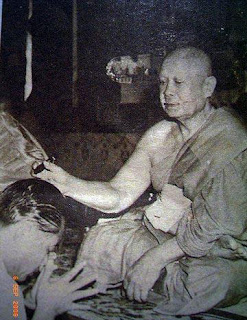*Come with 2nd place award competition certificate.
Beautiful & Original condition. Without repair, touch-up & four corners without chip off.
Originally, Somdej Phra Buddhacharn Nuam of Wat Anongkaram was elected to be the president of the ceremony but due to him falling ill at the period of time, Lung Pu Nak, Wat Rakhang, was selected to represent him instead.
The materials collected consisted of:
1. Broken fragment of Somdej Phra Buddhacharn Toh Somdej amulets from Wat Rakhang and Wat Bangkhunphrom.
2. Filing of Phra Kring Wat Suthat that were consecrated in B.E.2485.
3. Somdej amulets that were given out by Luang Pu Poo, Wat Inn.
4. Phong wiset that were leftover by Luang Phor Doem, Wat Nongpho.
5. Many types of powder specially donated by many famous monks, etc.
The types of materials that were used to bind and mix into these raw materials were:
1. Nur Phong Kesorn (Powder of crushed jasmine flower petals)
2. Nur Phong Kasen Boon Nak (Special powder named after Phaya Nak or Naga)
3. Nur Phong Kesorn Bua Luang (Powder of crushed Lotus flower petals)
4. Nur Phong Kaset Pikoon (Powder of a type of farm wood)
5. Poon Kao (Limestone powder)
6. Kradat Faang (Rice paper)
7. Namman Maphrao (Coconut oil)
8. Dinsor Phong (Chalk powder)
9. Nam Oi (Sugarcane), etc.
On 22nd October, B.E.2495, the group of 14 monks who gathered for a mass chanting to chant on the materials of the amulets were:
1. Phra Thep Wae Tee, Wat Sam Phraya
2. Phra Pawana Koht, Wat Paknam
3. Phra Raj Molee, Wat Rakhang
4. Phra Pawana Wikrom, Wat Rakhang
5. Phra See Somphot, Wat Suthat
6. Luang Phor Chaeng, Wat Bang Pang
7. Phrakru Winai Ton, Wat Samphanthawong
8. Phrakru Sompanyop Rakat, Wat Prodges
9. Phra Acharn Plee, Wat Suan Ploo
10. Phrakru Arkom Soonthorn, Wat Suthat
11. Phra Palad Pleang, Wat Ganya Nimit
12. Phra Acharn Baideega Banyat, Wat Suthat
13. Phrakru Sung, Wat Indraviharn
14. Phrakru Mongkhol Wichit, Wat Anongkaram
The amulets were using various moulds which produced a total of 84,000 pieces and were all individually hand cut using gold knives. the amulets were collected in trays and were kept under shade, not under sunlight, to be dried natural conditions.
After all the amulets were finally moulded, they were placed in the Bosth (Main chanting hall) by the committee who were in charge and were surrounded by auspicious candles that were placed in the 8 directions. The candles were watched over by committee members on a rotational duty to prevent the candles from burning out or blowing out.
Those who were there witnessed the beautiful glow of the candlelight illuminating the amulets and the place was serene and solemn. Offerings were made to a big photograph of Somdej Phra Buddhacharn Toh that was placed in the hall to invite him to witness and preside over the blessing ceremony.
On 5th November, B.E.2495, a 2nd mass chanting was to be performed on the completed amulets prior to distribution to the public. At the auspicious hour of 4.20pm, the victory candles were lighted and all the monks, Brahms (white-robed Brahmins) and devotees bowed down and paid respects to the Buddha and the president of the ceremony.
After a short chanting to the Buddha and chanting the invitation to the Devas, a speech was delivered by the president of the ceremony. The motive of making these batch of Somdej amulets was to distribute and remind people of the Buddhism and the follow its doctrine. It was also to carry on the lineage of Somdej Phra Buddhacharn Toh of his famous Somdej amulets. Consecrating a big quantity was to allow as many people as possible to have a piece that contain the legacy of Somdej Phra Buddhacharn Toh.
After the speech was delivered, a group of 12 monks were invited to perform mass chanting on the amulets participated in the main chanting to complete the consecration of the amulets. They were:
1. Luang Phor Sodh, Wat Paknam, Thonburi
2. Luang Pu Puak, Wat King Keaw, Samutprakan
3. Luang Pu Rian, Wat Nongbua, Kanchanaburi
4. Luang Phor Chuang, Wat Bang Pae Rok Tai, Nonthaburi
5. Luang Phor Roong, Wat Thakrabue, Samut Sakorn
6. Phra Palad Taeng Guay, Wat Pradoochimplee, Thonburi
7. Luang Phor Chong, Wat Natangnok, Ayuttaya
8. Luang Phor Nor, Wat Klang Tharua, Ayuttaya
9. Luang Phor Samniang, Wat Weruwanaram, Nakhon Pathom
10. Luang Phor Chaeng, Wat Bang Pang, Nonthaburi
11. Luang Pu Nak, Wat Rakhang, Thonburi
12. Luang Phor Ha, Wat Don Gai Dee, Samutsakorn
After the ceremony was over, the amulets were distributed out the everyone who attended the ceremony.
Today, there are many replicas in the market and it requires extensive study of genuine pieces before any attempt is made to buy this amulet. Also there is some confusion regarding the batches with the police crest imprint behind, which DO NOT belong to this batch of Somdej Nai Phau amulets.
(The informations for Phra Somdej Nai Phau amulets is from others website. Just used for reference.)
 |
| Luang Pu Nak, Wat Rakhang Kositaram, Bangkok. |




























